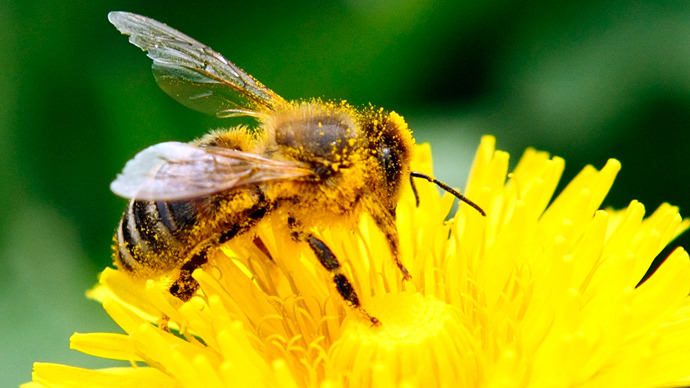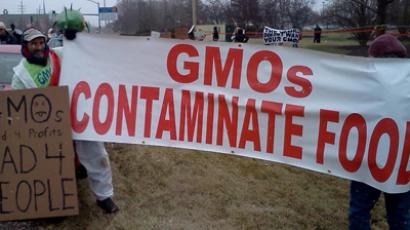US approves new pesticides linked to mass bee deaths as EU enacts ban

In the wake of a massive US Department of Agriculture report highlighting the continuing large-scale death of honeybees, environmental groups are left wondering why the Environmental Protection Agency has decided to approve a "highly toxic" new pesticide.
The continuing mass death of honeybees, known scientifically as Colony Collapse Disorder (CCD) and a “pollinator crisis,” could well strain production of over 100 crops in the US including apples, zucchinis, avocados and plums. The agriculture value of these products is estimated at over $200 billion globally per year.
As RT recently reported, a new USDA report has taken a broad look at the decline of bee colonies in the country, highlighting a dire situation as the number of colonies has plummeted from 3 million in 1990 to 2.5 million this year. Demonstrating that the decline is a long-term issue, that same report points to the existence of 6 million honey bee colonies in 1947.
Though dire, the report does not offer any immediate solutions, as scientists continue to examine the potential causes for the mass colony collapses, during which adult bees abandon their hives, along with the queen, brood and food supplies.
The USDA cites “multiple factors… including parasites and disease, genetics, poor nutrition and pesticide exposure,” while also citing last summer’s drought as a contributing factor.
Many environmental groups seem convinced that pesticides are a main factor in the continuing colony collapse situation. One group, Beyond Pesticides, has called the EPA’s recent green light for use of a new insecticide known as sulfoxaflor irresponsible in light of its “highly toxic” classification for honey bees.
In late April, the European Union voted to enact a two-year moratorium on the use of neonicotinoid pesticides (sulfoxaflor is considered by many to be a "fourth-generation neonicotinoid") in light of scientific studies that indicate their harm to bees.
As in the US, a number of European countries have also been monitoring declining health and colony collapses in their bee populations, including France, the Netherlands, Greece, Italy, Portugal and Spain.
Groups such as the Pesticide Action Network (PAN) have praised the continent-wide ban.

“The EU vote comes after significant findings by the European Food Safety Agency that these pesticides pose an unacceptable risk to bees and their use should be restricted. Along with habitat loss and pathogens, a growing body of science points to neonicotinoid pesticides as a key factor in drastically declining bee populations,” said a statement by PAN.
Meanwhile, major pesticide manufacturers scoff at the two-year European ban.
“As a science-based company, Bayer CropScience is disappointed that clear scientific evidence has taken a backseat in the decisionmaking process. This disproportionate decision is a missed opportunity to reach a solution that takes into consideration all of the existing product-stewardship measures and broad stakeholder concerns.”
Unlike the straight-cut decision taken by the EU, the same USDA report highlighting plummeting bee colony numbers in the US seems to undermine the possibility of even a temporary ban on potentially harmful pesticides.
According to one veteran environmental reporter, Bryan Walsh of Time Magazine, the USDA report in introducing several “potential” factors in CCD skirts the issue of pesticides altogether.
“The USDA report mostly withholds judgment on neonicotinoids, citing the need for more research, and the Environmental Protection Agency is conducting a very slow review of the evidence,” says Walsh.
The review cited by the agency is slated to take an additional five years. Meanwhile, the domesticated bee population in the US has reached a 50-year low.
According to Walsh, in a normal year the commercial bee industry
would expect to lose 10 to 15 per cent of its colonies, but over
the past five years mortality rates have increased dramatically,
ranging from 28 to 33 per cent.
Unlike in the EU, where at least in terms of policy lawmakers were
not willing to take a chance on pesticides, the USDA’s report
points to various possible causes for the massive colony collapse,
including: A parasitic mite called Varroa destructor; a bacterial
disease called European foulbrood; and the use of pesticides,
including neonicotinoids, a neuroactive chemical.
Yet, almost paradoxically, the USDA seems to lend further study a time frame which seems glacial compared to its own dire estimates of mass bee die offs.
“Currently, the survivorship of honeybee colonies is too low for us to be confident in our ability to meet the pollination demands of US agricultural crops,” the USDA report said.














